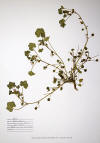

_small.jpg)

WILD
FOODIES' HOME PAGE
PLANT PROFILE LIST
NAME: Common Mallow
LATIN NAME / FAMILY: Malva neglecta / Malvaceae
OTHER COMMON NAME(S): buttonweed, cheeseplant, dwarf mallow and roundleaf mallow
CONDITIONS: full
sun
|
PARTS: |
EDIBLE |
TASTE |
RAW/COOK |
SEASON |
|
All |
|
|
|
Spring-Fall |
|
Shoots |
|
|
|
|
|
Leaves |
|
mellow |
Best to cook |
Winter-Fall |
|
Buds/Flowers |
|
mellow |
RAW/COOK |
Spring-Fall |
|
Fruits |
|
|
|
|
|
Roots |
|
mellow |
DRY/COOK |
Spring-Fall |
|
Seeds |
|
nutty |
RAW/COOK |
Spring-Fall |
|
Nuts |
|
|
|
|
|
Pods |
|
|
|
|
|
Stalk |
|
|
|
|
|
Bark |
|
|
|
|
PORTION: medium
COMMENT: Looks like a geranium. Related to Okra. All parts edible. Leaves are available even in mid-winter. Unlike High Mallow’s smooth leaves, Common Mallow’s leaves are fuzzy to taste and could cause a scratchy sensation in the throat. Should probably cook the entire plant. Leaves and root mucilaginous. Use as a soup thickener. Immature seed pod looks like a tiny cheese wheel, said to have nutty flavor. “A decoction of the roots is used as an egg-white substitute for making meringue. The roots are brought to the boil in water and then simmered until the water becomes quite thick. This liquid can then be whisked in much the same way as egg whites[K]. A tea can be made from the dried leaves.” (1) During late summer the ripening fruit pods (cheese wheel) can be harvested and used much like a caper.(9)
"Common mallow is in the same plant family as okra, and shares the same mucilaginous properties. (It's slightly slimy, and can be used for thickening.) It's high in calcium and magnesium, potassium, zinc, iron, selenium, sodium, iodine, vitamin B complex, vitamin A, and vitamin C. Katrina uses the young leaves raw in salad, mixed with other greens. She dices the whole plant and steeps it in water for several hours to create a thick liquid vegan egg white substitute. Cook the root like a potato, or chop and blend to make “mallow milk”. Chop and cook mature leaves in recipes to thicken and bind (think okra or egg substitute)." (8)
CAUTION: Raw leaves are fuzzy to taste could irritate the throat.
NUTRITION/MEDICINAL: Seeds contain 21% protein and 15.2% fat. (3) MEDICINAL: Anti-inflammatory; Antiphlogistic; Astringent; Demulcent; Diuretic; Emollient; Expectorant; Laxative; Poultice; Purgative; Salve. (1) Also: https://www.webmd.com/vitamins/ai/ingredientmono-192/mallow
LOOK-A-LIKES:
POISONOUS LOOK-A-LIKES:
OTHER USES: Cream, yellow and green dyes can be obtained from the plant and the seed heads. The root is used as a toothbrush. (1)
SOURCE LINKS (may include nutritional and medicinal info, plus other uses):
http://www.eattheweeds.com/mallow-madness-the-false-roselle (Hibiscus is a related species)
http://www.foragingtexas.com/2008/08/mallow.html (good photos)
https://www.foragesf.com/blog/2019/5/1/mallow-youve-gotta-try-any-plant-that-has-a-cheese-wheel
https://pullupyourplants.medium.com/pull-up-your-plants-mallow-e1ef51ac8c13
https://commonsensehome.com/common-mallow (interesting website)
https://eattheplanet.org/common-mallow-a-wild-edible-often-found-in-lawns
https://www.gardenbetty.com/mallow-the-everywhere-edible-weed (good article)